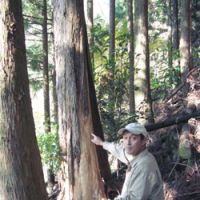When Hideyuki Yoshizawa goes into the woods, he doesn't wear the usual silver bells meant to scare off bears. He's given up smoking, too, to eliminate that tell-tale human smell. That's because he wants more than anything else to meet a bear in the forest.
"Black bears are so mysterious. I want to know more about them. I want to know all sorts of things — so many things I can't even put it into words," says the 43-year-old forestry worker in the city of Owase, Mie Prefecture. That insatiable curiosity about what local bears eat, where they roam, and how many individuals exist with only humans as a natural enemy has sent Yoshizawa tramping through Mie's steep forested mountains nearly every day after work and every weekend for the past 10 years.
The region's bears are highly unusual in that they inhabit evergreen broadleaf as well as deciduous forests, but information about them is scarce. During the 1970s and '80s, they were killed in large numbers to reduce damage to plantation forests, a key local industry, as each spring they tend to strip the bark of cedar and cypress trees to get at the sweet sap underneath. That renders the trees vulnerable to rot and makes them economically useless for timber. Hunting left Mie, Nara and Wakayama prefectures with an endangered bear population estimated at just 180 animals. A similar history reduced the Shikoku population to fewer than 30.
Bear hunting has been banned in Mie since 1994, and no injuries have occurred since 2005. Yoshizawa often finds claw-marks on stripped trees, however, as well as the nestlike clumps of dead branches bears build as platforms high in oaks and other trees that they climb to eat acorns.
Just once has he had the chance to observe a bear up close.
"Bears normally avoid humans, but when they're eating, they're oblivious," he says. This one was eating acorns. He watched it from a distance of 15 meters for 2 1/2 hours.
"I felt like I was watching TV. It would noisily munch on acorns for 20 minutes, then become silent for five minutes, then start eating again. It was just taking its time and eating. It was incredibly cute to see."
Yoshizawa monitors five automatic-sensor cameras in the mountains and has been tracking one bear since last year using a telemetry collar fitted to it by prefectural officials called in by a hunter after the animal was caught in a snare he'd set for wild boar. Yoshizawa often captures mother-cub pairs on the cameras, but it is unclear if the small, isolated population will be able to recover.
His next project is to identify individuals by photographing them standing upright — as suggested by their Japanese name, tsuki-no-wa guma (meaning, "moon bear") each animal has a crescent-shaped white marking on its chest, and as these markings are unique, they can be used for identification.
That, he hopes, will take him one step closer to understanding the mysterious animals that have enthralled him for the past decade.




















With your current subscription plan you can comment on stories. However, before writing your first comment, please create a display name in the Profile section of your subscriber account page.